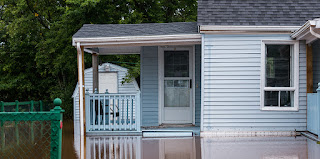losses that accompany this very common disaster
Ninety percent of all natural disasters in the United States involve flooding, and flood damage strikes frequently in low or moderate risk areas. Homeowners policies don’t cover flooding so—whatever your area’s risk level—learn about flood insurance protections.
The risk of flood damage or loss
According to the Federal Emergency Management Agency (FEMA) floods—including inland flooding, flash floods and
Protect yourself from the losses that accompany this very common disaster
Ninety percent of all natural disasters in the United States involve flooding, and flood damage strikes frequently in low or moderate risk areas. Homeowners policies don’t cover flooding so—whatever your area’s risk level—learn about flood insurance protections.
The risk of flood damage or loss
According to the Federal Emergency Management Agency (FEMA) floods—including inland flooding, flash floods and flooding from seasonal storms—occur in every region of the United States. In fact, 90 percent of all natural disasters in the U.S. involve some type of flooding.
If you're moving into a new home, apartment or business location, ask your mortgage lender, your local officials or your insurance professional if the location has been known to flood. The National Flood Insurance Program (NFIP) will also be able to provide flood risk information on your area.
Even if you don't live in a high flood risk area, you're in some danger of loss from a flood, because 20 percent of all flood claims are filed in low to moderate flood risk areas. That means, you should know how to prepare for the possibility of a flood, know your flood insurance options and obtain adequate coverage.
Flood insurance basics
Insuring yourself against a flood is a little different than other policies.
Floods are not covered under homeowners and renters policies. Only a specific flood insurance policy will cover home flood related losses.
Most flood insurance is administered through the federal government. Homeowners, renters and businesses can purchase flood policies from an insurer under contract with FEMA. Federal flood insurance is available where the local government has adopted adequate flood plain management regulations under the NFIP—and many communities participate in the program.
Flood insurance covers direct physical losses from floods and losses resulting from flood related erosion caused by waves or currents of water exceeding anticipated cyclical levels and accompanied by a severe storm, flash flood, abnormal tide surge or a similar situation that results in flooding.
Flood insurance coverage for the structure and contents of the home are sold separately. Buildings are covered for replacement cost, but coverage for personal property is available on an actual cash value basis only.
The maximum flood insurance coverage amount is $250,000 for the structure of the home and $100,000 for the contents of the home. ("Excess" coverage over and above the maximums that are available from NFIP is offered by private insurers.)
Flood losses for cars are covered under the optional, comprehensive portion of a standard automobile insurance policy.
Commercial flood insurance is available from the NFIP; it provides up to $500,000 of coverage for your building and up to $500,000 for its contents. You can also purchase what’s called “excess” insurance coverage to rebuild properties valued above those limits.
It requires a waiting period – There is a 30-day waiting period before a flood insurance policy takes effect, so don’t wait until the last minute to purchase it.
It can be augmented with "excess" insurance – The NFIP policy maximums are inadequate to fully cover some people's assets so a growing number of private insurers have begun offering excess flood policies, intended to provide water damage protection to homeowners over and above the coverage provided by the NFIP policies. Some private insurers are also starting to offer “first dollar” flood policies.
What if I don't have flood insurance and there's a flood?
Having a flood insurance policy is way to protect your assets most fully from the cost of flood damages and loss.
Without insurance, relief from floods primarily comes in the form of loans. If your community is declared a disaster area, no-interest or low-interest loans are often made available by the federal government as part of the recovery effort. However, these loans must be paid back, which means you're still liable for the entire cost of your damages or losses
- Gas/Electricity
- Loans CPC
- Mortgage
- Degree
- Attorney
- Donate
- Lawyer
- Conference Call
- Credit
- Technology
- Chicago electricity rates
- Electricity cost per kWh Illinois
- Chicago gas
- Average eelectric
- How much electricity does Chicago use
- Chicago gas provider
- Average electric bill Chicago studio
- Average electric bill Chicago 2020
- Does ComEd provide gas
- Average electric bill Chicago 1 bedroom
- Average cost of electricity per month in Illinois
- Best gas company in Chicago

Comments
Post a Comment